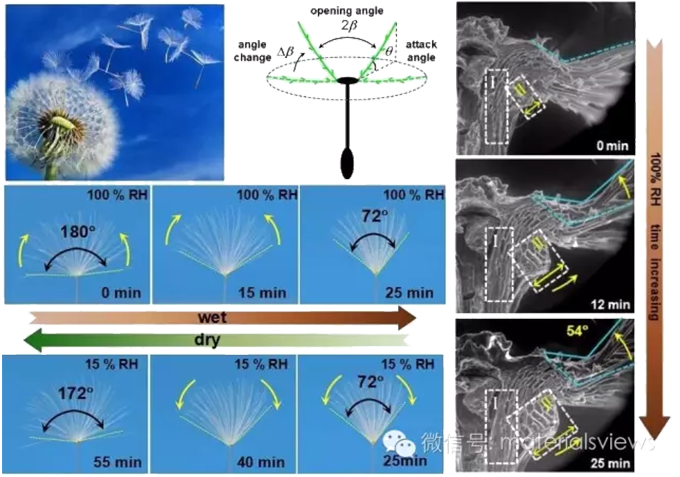After long-term evolution, organisms in nature have developed a variety of intelligent survival strategies, especially in the efficient use of water resources in the surrounding environment, showing a variety of unique properties, such as using the change of environmental humidity, pine cones realize the release of seeds, and wheat realizes the self-drive of seeds into the soil. These strategies allow organisms to better adapt to various living environments. Research in this field has provided many inspirations for scientists to design and prepare new smart responsive materials. At the heart of these unique functions are the anisotropy and hierarchical microstructure of the organism. Among them, changes or reconstructions of biological structures in response to environmental humidity are particularly fascinating, giving organisms many unique functions. The crown hair of the mature dandelion seed is in the shape of a parachute, which enables the dandelion to be spread over large areas and long distances by wind. The study found that the shape of the crest, or how the array of fibers is arranged, changes with atmospheric humidity. However, the mechanism of the response of the spatial morphology of this crown hair fiber to humidity and its influence on dandelion propagation and its regulatory mechanism have not been revealed.

[Figure 1: The opening and closing reversible motion of dandelion crown hair regulated by environmental humidity and its observation by scanning electron microscopy in situ]
Using environmental scanning electron microscopy (SEM), Liu Huan's research group at Beihang University revealed in situ the "open-close" movement behavior of dandelion crown hair driven by environmental humidity: that is, with the increase/decrease of environmental humidity, the tensile Angle of the radial crown hair fiber array will decrease/increase. Studies have shown that the mechanism lies in the different lateral expansion behaviors of two types of oblique tracheids (region I and region II in the figure) in the pulvinus connected to the crown hair under humidity environment: compared with region I, the tracheids in region II exhibit significantly increased lateral expansion, resulting in normal stress driving the crown hair movement. Through theoretical simulation and experimental results, it is revealed that the "opening and closing" of dandelion crown hair driven by ambient humidity can regulate its flight behavior in the air. Theoretical calculation shows that the force behavior of the crown under the action of the flow field in the air is related to the projected area in the plane, so the force of the crown under different opening angles in the air is different. The experimental results confirmed the flight behavior of dandelion controlled by environmental humidity: under high environmental humidity, the crown hair closes, the flight resistance is reduced, the falling speed is accelerated, and the propagation distance is shortened; Under low ambient humidity, the crown opens, the resistance to flight in the air increases, the falling speed slows, and the propagation distance increases. The moisture response behavior of dandelion crown can effectively improve the reproduction probability of the seeds carried by dandelion (high humidity environment is favorable for seed reproduction), and is conducive to its long-distance dissemination under dry air.

[Figure 2: Force analysis and experimental results of dandelion crown hair with different opening angles under the action of flow field in air]
Inspired by this, the author designed an integrated prototype device based on fiber and hydrogel, and realized the control of the shape of the fiber array with humidity response. Dandelion's "close-open" crown driven by ambient humidity provides a new idea for the design of a new type of intelligent and responsive micro-aerial vehicle.
This work is published as a cover article in Advanced Functional Materials (DOI: 10.1002/adfm.201602596). The first author is Meng Qingan, a PhD student at the School of Chemistry, Beijing University of Aeronautics and Astronautics.
From: MaterialsViews

